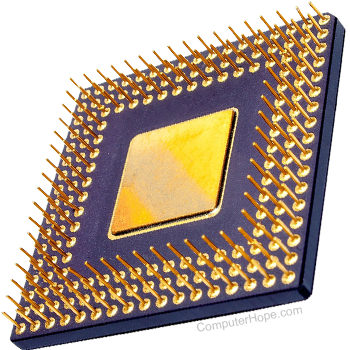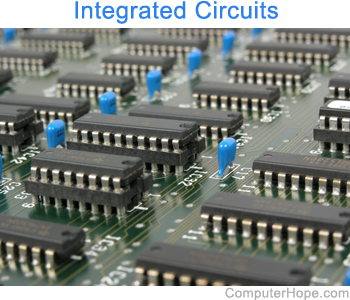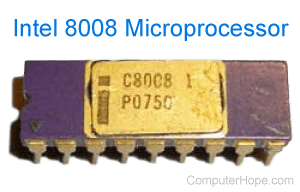Computer processor history

Listed below are the important events in history relating to computer processors, including release dates for many popular and widely used computer processors.
1823
Baron Jons Jackob Berzelius discovered silicon (Si), which today is the basic component of processors.
1903
Nikola Tesla patented electrical logic circuits called "gates" or "switches" in 1903.
1947
John Bardeen, Walter Brattain, and William Shockley invented the first transistor at the Bell Laboratories on December 23, 1947.
1948
John Bardeen, Walter Brattain, and William Shockley patented the first transistor in 1948.
1956
John Bardeen, Walter Brattain, and William Shockley were awarded the Nobel Prize in physics for their work on the transistor.
1958

The first working IC (integrated circuit) was developed by Robert Noyce of Fairchild Semiconductor and Jack Kilby of Texas Instruments. The first IC was demonstrated on September 12, 1958. (Geoffrey Dummer is credited as the first person to conceptualize and build a prototype of the integrated circuit.)
1960
IBM developed the first automatic mass-production facility for transistors in New York in 1960.
1965
On April 19, 1965, Gordon Moore made an observation about integrated circuits that became known as Moore's Law.
1968

Intel Corporation was founded by Robert Noyce and Gordon Moore in 1968.
1969

AMD (Advanced Micro Devices) was founded on May 1, 1969.
1971
Intel, with the help of Ted Hoff, introduced the world's first microprocessor, the Intel 4004, on November 15, 1971. The 4004 had 2,300 transistors, performed 60,000 OPS (operations per second), addressed 640 bytes of memory, and cost $200.00.
1972

Intel introduced the 8008 processor on April 1, 1972.
1974
Motorola introduced its first processor in 1974, the MC6800, an 8-bit processor featuring a 1-2 MHz clock frequency.
Intel's improved microprocessor chip was introduced on April 1, 1974; the 8080 became a standard in the computer industry.
1975
The MOS (metal-oxide-semiconductor) Technology 6502 processor was introduced in 1975 as a faster and less expensive version of the Intel 8080. The 6502 was used in video game consoles, like the Atari 2600 and Nintendo Entertainment System, and computers, like the Apple II and Commodore 64.
The MN1610 processor was released by Panafacom in 1975. The MN1610 was the first single-chip 16-bit processor, as reported by Fujitsu.
1976
Intel introduced the 8085 processor in March 1976.
Zilog released its first processor, the Z80, in July 1976. An 8-bit processor, the Z80 was primarily designed for embedded systems and used in many desktop computers.
1977
Apple was incorporated by Steve Wozniak and Steve Jobs, on January 4, 1977.
1978
The Intel 8086 was introduced on June 8, 1978.
1979
The Intel 8088 was released on June 1, 1979.
The Motorola 68000, a 16/32-bit processor, was released in 1979 and later chosen as the processor for the Apple Macintosh and Amiga computers.
1982
National Semiconductor released the 32016 processor, the first 32-bit general use processor, in 1982.
The Intel 80286 was introduced on February 1, 1982.
Sun Microsystems was founded in 1982.
1985
Acorn Computers completed developing the first ARM (Advanced RISC Machine) processor prototype, the ARM1 (Acorn RISC Machine 1), on April 26, 1985.
Intel introduced the first 80386 in October 1985.
1987
The SPARC (Scalar Processor Architecture) processor was introduced by Sun.
1988

Cyrix was founded in 1988.
Intel 80386SX was introduced in 1988.
1989
Cyrix released its first coprocessors, the FasMath 83D87 and 83S87, in 1989. These were x87 compatible and designed for 386 computers. The FasMath coprocessors were up to 50% faster than the Intel 80387 processor.
1990
ARM Holdings was founded in 1990.
1991
AMD introduced the AM386 microprocessor family in March 1991.
Intel introduced the Intel 486SX chip in April to help bring a lower-cost processor to the PC (personal computer) market, selling for $258.00.
1992
Intel released the 486DX2 chip on March 2, 1992, with a clock doubling ability that generates higher operating speeds.
1993
The first processor based on the 32-bit PowerPC instruction set, the PowerPC 601, was released in 1993. It was developed by the AIM alliance, a partnership between Apple, IBM, and Motorola.
Intel released the Pentium processor on March 22, 1993. The processor was a 60 MHz processor, incorporating 3.1 million transistors, and sold for $878.00.
NVIDIA was founded in 1993.
Rise Technology was founded in 1993 by David Lin.
1994
Intel released the second generation of Intel Pentium processors on March 7, 1994.
1995
Cyrix released the Cx5x86 processor in 1995 to compete with the Intel Pentium processors.
Intel introduced the Intel Pentium Pro in November 1995.
1996
Cyrix released its MediaGX processor in 1996. It combined a processor with sound and video processing on one chip.
Intel announced the availability of the Pentium 150 MHz with 60 MHz bus and 166 MHz with 66 MHz bus on January 4, 1996.
AMD introduced the K5 processor on March 27, 1996, with speeds of 75 MHz to 133 MHz and bus speeds of 50 MHz, 60 MHz, or 66 MHz. The K5 was the first processor developed completely in-house by AMD.
1997
AMD released its K6 processor line in April 1997, with speeds of 166 MHz to 300 MHz and a 66 MHz bus speed.
Intel Pentium II was introduced on May 7, 1997.
1998
AMD introduced its new K6-2 processor line on May 28, 1998, with speeds of 266 MHz to 550 MHz and bus speeds of 66 MHz to 100 MHz. The K6-2 processor was an enhanced version of AMD's K6 processor.
Intel released the first Xeon processor, the Pentium II Xeon 400 (512 K or 1 M cache, 400 MHz, 100 MHz FSB), in June 1998.
1999
Intel released the Celeron 366 MHz and 400 MHz processors on January 4, 1999.
AMD released its K6-III processors on February 22, 1999, with speeds of 400 MHz or 450 MHz and bus speeds of 66 MHz to 100 MHz. It also featured an on-die L2 cache.
The Intel Pentium III 500 MHz was released on February 26, 1999.
The Intel Pentium III 550 MHz was released on May 17, 1999.
AMD introduced the Athlon processor series on June 23, 1999. The Athlon would be produced for the next six years at speeds ranging from 500 MHz to 2.33 GHz.
The Intel Pentium III 600 MHz was released on August 2, 1999.
The Intel Pentium III 533B and 600B MHz was released on September 27, 1999.
The Intel Pentium III Coppermine series was introduced on October 25, 1999.
AMD introduced the Athlon K75 processor on November 29, 1999. The K75 was the world's first processor to reach a speed of 1 GHz.
2000
On January 5, 2000, AMD released the 800 MHz Athlon processor.
Intel released the Celeron 533 MHz with a 66 MHz bus processor on January 4, 2000.
AMD released the Duron processor on June 19, 2000, with speeds of 600 MHz to 1.8 GHz and bus speeds of 200 MHz to 266 MHz. The Duron was built on the same K7 architecture as the Athlon processor.
Intel announced on August 28th that it would recall its 1.3 GHz Pentium III processors due to a glitch. Users with these processors should contact their vendors for additional information about the recall.
2001
On January 3, 2001, Intel released the 800 MHz Celeron processor with a 100 MHz bus.
On January 3, 2001, Intel released the 1.3 GHz Pentium 4 processor.
AMD announced a new branding scheme on October 9, 2001. Instead of identifying processors by its clock speed, the AMD Athlon XP processors would bear monikers of 1500+, 1600+, 1700+, 1800+, 1900+, 2000+, etc. Each higher model number represented a higher clock speed.
2002
Intel released the Celeron 1.3 GHz with a 100 MHz bus and 256 kB of level 2 cache in 2002.
2003
Intel Pentium M was introduced in March 2003.
AMD released the first single-core Opteron processors, with speeds of 1.4 GHz to 2.4 GHz and 1024 KB L2 cache, on April 22, 2003.
AMD released the first Athlon 64 processor, the 3200+ model, and the first Athlon 64 FX processor, the FX-51 model, on September 23, 2003.
2004
AMD released the first Sempron processor on July 28, 2004, with a 1.5 GHz to 2.0 GHz clock speed and 166 MHz bus speed.
2005
AMD released its first dual-core processor, the Athlon 64 X2 3800+ (2.0 GHz, 512 KB L2 cache per core), on April 21, 2005.
2006
AMD released its new Athlon 64 FX-60 processor, featuring a 2x 1024 KB L2 cache, on January 9, 2006.
Intel released the Core 2 Duo processor E6320 (4 M cache, 1.86 GHz, 1066 MHz FSB) on April 22, 2006.
Intel introduced the Intel Core 2 Duo processors with the Core 2 Duo processor E6300 (2 M cache, 1.86 GHz, 1066 MHz FSB) on July 27, 2006.
Intel introduced the Intel Core 2 Duo processor for the laptop computer with the Core 2 Duo processor T5500 and other Core 2 Duo T series processors in August 2006.
2007
Intel released the Core 2 Quad processor Q6600 (8 M cache, 2.40 GHz, 1066 MHz FSB) in January 2007.
Intel released the Core 2 Duo processor E4300 (2 M cache, 1.80 GHz, 800 MHz FSB) on January 21, 2007.
Intel released the Core 2 Quad processor Q6700 (8 M cache, 2.67 GHz, 1066 MHz FSB) in April 2007.
Intel released the Core 2 Duo processor E4400 (2 M cache, 2.00 GHz, 800 MHz FSB) on April 22, 2007.
AMD renamed the Athlon 64 X2 processor line to Athlon X2 and released the first in that line, the Brisbane series (1.9 to 2.6 GHz, 512 KB L2 cache) on June 1, 2007.
Intel released the Core 2 Duo processor E4500 (2 M cache, 2.20 GHz, 800 MHz FSB) on July 22, 2007.
Intel released the Core 2 Duo processor E4600 (2 M cache, 2.40 GHz, 800 MHz FSB) on October 21, 2007.
AMD released the first Phenom X4 processors (2 M cache, 1.8 GHz to 2.6 GHz, 1066 MHz FSB) on November 19, 2007.
2008
Intel released the Core 2 Quad processor Q9300 and the Core 2 Quad processor Q9450 in March 2008.
Intel released the Core 2 Duo processor E4700 (2 M cache, 2.60 GHz, 800 MHz FSB) on March 2, 2008.
AMD released the first Phenom X3 processors (2 M cache, 2.1 GHz to 2.5 GHz, 1066 MHz FSB) on March 27, 2008.
Intel released the first of the Intel Atom series of processors, the Z5xx series, in April 2008. They were single-core processors with a 200 MHz GPU (graphics processing unit).
Intel released the Core 2 Duo processor E7200 (3 M cache, 2.53 GHz, 1066 MHz FSB) on April 20, 2008.
Intel released the Core 2 Duo processor E7300 (3 M cache, 2.66 GHz, 1066 MHz FSB) on August 10, 2008.
Intel released several Core 2 Quad processors in August 2008: the Q8200, the Q9400, and the Q9650.
AMD announced on October 7, 2008, it planned to go fabless.
Intel released the Core 2 Duo processor E7400 (3 M cache, 2.80 GHz, 1066 MHz FSB) on October 19, 2008.
Intel released the first Core i7 desktop processors in November 2008: the i7-920, the i7-940, and the i7-965 Extreme Edition.
2009
AMD released the first Phenom II X4 (quad-core) processors (6 M cache, 2.5 to 3.7 GHz, 1066 MHz, or 1333 MHz FSB) on January 8, 2009.
AMD released the first Athlon Neo processor, the MV-40 model (1.6 GHz and 512 KB L2 cache) on January 8, 2009.
Intel released the Core 2 Duo processor E7500 (3 M cache, 2.93 GHz, 1066 MHz FSB) on January 18, 2009.
AMD released the first Phenom II X3 (triple-core) processors (6 M cache, 2.5 to 3.0 GHz, 1066 MHz, or 1333 MHz FSB) on February 9, 2009.
AMD broke off its manufacturing and formed GlobalFoundries on March 4, 2009.
Intel released the Core 2 Quad processor Q8400 (4 M cache, 2.67 GHz, 1333 MHz FSB) in April 2009.
Intel released the Core 2 Duo processor E7600 (3 M cache, 3.06 GHz, 1066 MHz FSB) on May 31, 2009.
AMD released the first Athlon II X2 (dual-core) processors (1024 KB L2 cache, 1.6 to 3.5 GHz, 1066 MHz, or 1333 MHz FSB) in June 2009.
AMD released the first Phenom II X2 (dual-core) processors (6 M cache, 3.0 to 3.5 GHz, 1066 MHz, or 1333 MHz FSB) on June 1, 2009.
AMD released the first Athlon II X4 (quad-core) processors (512 KB L2 cache, 2.2 to 3.1 GHz, 1066 MHz, or 1333 MHz FSB) in September 2009.
Intel released the first Core i7 mobile processor, the i7-720QM, in September 2009. It used the Socket G1 socket type, runs at 1.6 GHz, and features a 6 MB L3 cache.
Intel released the first Core i5 desktop processor with four cores, the i5-750 (8 M cache, 2.67 GHz, 1333 MHz FSB), on September 8, 2009.
AMD released the first Athlon II X3 (triple-core) processors in October 2009.
2010
Intel released the Core 2 Quad processor Q9500 (6 M cache, 2.83 GHz, 1333 MHz FSB) in January 2010.
Intel released the first Core i5 mobile processors, the i5-430M and the i5-520E, in January 2010.
Intel released the first Core i5 desktop processor over 3.0 GHz, the i5-650, in January 2010.
Intel released the first Core i3 desktop processors, the i3-530, and i3-540 on January 7, 2010.
Intel released the first Core i3 mobile processors, the i3-330M (3 M cache, 2.13 GHz, 1066 MHz FSB) and the i3-350M, on January 7, 2010.
AMD released the first Phenom II X6 (hex/six-core) processors on April 27, 2010.
Intel released the first Core i7 desktop processor with six cores, the i3-970, in July 2010. It runs at 3.2 GHz and features a 12 MB L3 cache.
2011
Intel released seven new Core i5 processors with four cores, the i5-2xxx series, in January 2011.
AMD released the first mobile processors in its A4 line, the A4-3300M and the A4-3310MX, on June 14, 2011.
AMD released the first mobile processors in its A6 line, the A6-3400M and the A6-3410MX, on June 14, 2011.
AMD released the first mobile processors in its A8 line, the A8-3500M, the A8-3510MX, and the A8-3530MX, on June 14, 2011.
AMD released the first desktop processor in its A6 line, the A6-3650 (4 M L2 cache, 2.6 GHz, 1866 MHz FSB), on June 30, 2011.
AMD released the first desktop processor in its A8 line, the A8-3850 (4 M L2 cache, 2.9 GHz, 1866 MHz FSB), on June 30, 2011.
AMD released the first desktop processors in its A4 line, the A4-3300 and the A4-3400, on September 7, 2011.
2012
AMD released the first desktop processors in its A10 line, the A10-5700 and the A10-5800K, on October 1, 2012.
2013
AMD released the Athlon II X2 280 on January 28, 2013. It had two cores and runs at 3.6 GHz.
Intel released its first processor to utilize the BGA-1364 socket and featured an Iris Pro Graphics 5200 GPU. Released in June 2013, it runs at 3.2 GHz and had 6 MB of L3 cache.
2014
AMD introduced the socket AM1 architecture and compatible processors, like the Sempron 2650, in April 2014.
AMD released its first Pro A series APU (accelerated processing unit) processors, the A6 Pro-7050B, A8 Pro-7150B, and A10 Pro-7350B, in June 2014. They feature on or two cores and run at 1.9 GHz to 2.2 GHz.
2017
AMD released its first Ryzen 7 processors, the 1700, 1700X, and 1800X models, on March 2, 2017. They have eight cores, running at 3.0 to 3.6 GHz, and feature a 16 MB L3 cache.
AMD released its first Ryzen 5 processors, the 1400, 1500X, 1600, and 1600X models, on April 11, 2017. They have four to six cores, running at 3.2 to 3.6 GHz, and feature 8 to 16 MB L3 cache.
Intel released the first Core i9 desktop processor, the i9-7900X, in June 2017. It used the LGA (land grid array) 2066 socket, runs at 3.3 GHz, had 10 cores, and features a 13.75 MB L3 cache.
AMD released its first Ryzen 3 processors, the Pro 1200 and Pro 1300 models, on June 29, 2017. They have four cores, running at 3.1 to 3.5 GHz, and feature an 8 MB L3 cache.
Intel released the first desktop processor with 12 cores, the Core i9-7920X, in August 2017. It runs at 2.9 GHz and features a 16.50 MB L3 cache.
AMD released its first processor with 16 cores, the Ryzen Threadripper 1950X, on August 10, 2017. It runs at 3.4 GHz and features a 32 MB L3 cache.
Intel released the first desktop processor with 14 cores, the Core i9-7940X, in September 2017. It runs at 3.1 GHz and features a 19.25 MB L3 cache.
Intel released the first desktop processor with 16 cores, the Core i9-7960X, in September 2017. It runs at 2.8 GHz and features a 22 MB L3 cache.
Intel released the first desktop processor with 18 cores, the Core i9-7980X, in September 2017. It runs at 2.6 GHz and features a 24.75 MB L3 cache.
2018
Intel released the first Core i9 mobile processor, the i9-8950HK, in April 2018. It used the BGA (ball grid array) 1440 socket, runs at 2.9 GHz, had six cores, and features a 12 MB L3 cache.
2020
AMD announced it was buying Xilinx for $35 billion on October 27, 2020.
Apple introduced its custom silicon with its first processor, the Apple M1, on November 10, 2020.
2021
Apple introduced updates to its custom silicon on October 18, 2021, the Apple M1 Pro and M1 Max processors.
